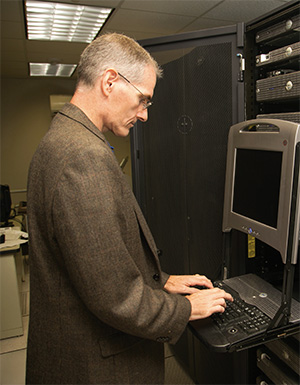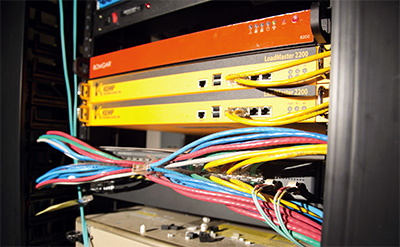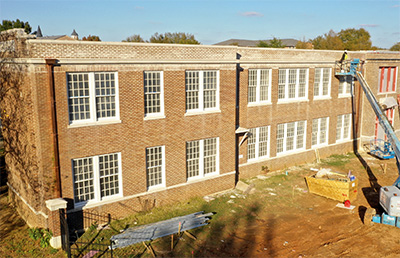“Time is the longest distance between two places.” -Tennessee Williams, The Glass Menagerie
As time marches on, partnerships, sustainability and ingenuity are leading The W into the future. Tomorrow’s technologies integrate into a historic campus daily. We may not know the future, but by working together, we will be the university for tomorrow.
 Technology never stops advancing, which is why Mississippi University for Women has three priorities that outline The W’s technological sustainability efforts: security, performance and redundancy.
Technology never stops advancing, which is why Mississippi University for Women has three priorities that outline The W’s technological sustainability efforts: security, performance and redundancy.
“Providing a safe and secure technology-based environment is always a moving target but paramount for computer transactions and data integrity. Performance impacts productivity and user experience, but isn’t infinitely available and is always dictated by budget availability. Redundancy helps to ensure continuity of operations while also helping to protect data and service availability,” said Rodney Godfrey, director of systems & networks at The W.
Each one of the outlined priorities has allowed The W to make many sizable infrastructure investments over the years that reinforce the university’s technological sustainability.
In 2016, the Department of Information Technology Services (ITS) completed a major switching infrastructure design and upgrade that boosted the university’s performance from 1Gbps to 10Gbps while simultaneously providing a path for further bandwidth expansion. Since 2016, new related infrastructure components have included new switches for renovated buildings, core firewalls and routers, data storage repositories, additional fiber installations and increased Internet bandwidth. In 2017, a disaster recovery technology project was implemented and is still under way. Though campus predates the 20th century and physical space is limited, the university’s advancement hasn’t stopped. “Though our physical footprint is limited, the amazing thing about technology is that it seems to infinitely expand our reach beyond four-walled buildings. Earlier this year, ITS installed new wireless bridge technology to connect unwired structures over Wi-Fi such as the newly renovated softball field for athletics and the new Physical Plant building that are adjacent to main campus buildings,” explained Godfrey.
 New wireless technology resulted in cost savings compared to installing the traditional underground fiber that would have required work on the railroad that runs through campus. The W may be smaller compared to other institutions, but Godfrey doesn’t view that as a negative.
New wireless technology resulted in cost savings compared to installing the traditional underground fiber that would have required work on the railroad that runs through campus. The W may be smaller compared to other institutions, but Godfrey doesn’t view that as a negative.
“Our smaller size isn’t without advantages. Due to a larger number of users or system complexities, larger institutions usually can’t move as fast and deploy services as quickly and/ or as affordably as we can,” said Godfrey.
He added that many complex projects such as campus Wi-Fi networks, server virtualization upgrades and complete email system migrations are completed within a few months, whereas larger institutions could take years to complete due to the sheer size and/or costs. The faculty and staff have directly benefited from one of the longest running programs.
“The Faculty/Staff and Lab PC Replacement Plan has been in place for 14 years and has reaped many benefits in terms of bulk costs savings, PC performance and administrative efficiencies. Trying to implement this type of PC Replacement Plan at larger universities would be very expensive and administratively challenging,” said Godfrey. During the holiday season, faculty and staff members will receive a new VOIP (Voice over IP) phone network that will save money and provide new features and enhancements.
Additionally, this project includes joining the Mississippi Optical Network (MissiON), which will provide significant cost savings. MissiON is a robust network that serves the Mississippi Research Consortium composed of Mississippi state universities and research entities. The network will provide network scaling options that offer affordable Internet circuit rates, remote disaster recovery site access and access to Internet2 services which will supplement our current Internet bandwidth demands and future-proof the longevity of our existing Internet circuit services.
Upgrades at The W expand past technology. When you drive through campus, individuals will notice a construction zone on Serenade Drive. A historic building is coming online with structural and technological upgrades.
 Construction on Turner Hall, formerly known as the Demonstration School, started in January 2018. The $8.2 million expansion and complete renovation will provide room for growth for the Speech-Language Pathology program, Speech and Hearing Clinic and a large, tiered, auditorium- style classroom for the College of Nursing and Health Sciences and other university programming.
Construction on Turner Hall, formerly known as the Demonstration School, started in January 2018. The $8.2 million expansion and complete renovation will provide room for growth for the Speech-Language Pathology program, Speech and Hearing Clinic and a large, tiered, auditorium- style classroom for the College of Nursing and Health Sciences and other university programming.
PryorMorrow served as the architecture/engineering firm responsible for the design on Turner Hall while also acting as the liaison between the university and TVA to ensure all necessary documentation and calculations compiled for the incentive process.
The partnership brought efficiencies that totaled more than $45,000 in incentives the university will receive from Tennessee Valley Association’s EnergyRight Solutions program. The program encourages both homeowners and businesses to make smarter energy use choices. The university’s application to the TVA program was approved in the spring of 2018.
Turner Hall will feature 100 percent LED lighting throughout the building, high-efficiency HVAC systems and a building automation system to monitor energy efficiency and control HVAC systems. The building also will have motion sensors for lighting as well as sensors to control power outlets when the building is vacant.
A technologically advanced window film will cover the original windowpanes that will allow each window to perform as modern-day insulated glass windows would while maintaining the historic aesthetics of the building.
Construction of Turner Hall is projected to be complete in July 2019. This project is funded from state general obligation bonds.
Another partnership with TVA that originated in 2011 continues to offer financial benefits to The W. The TVA- Enel X Demand Response Program offers recurring payments in return for reducing electricity consumption during abnormally high electricity demand times. Through real-time monitoring of energy consumption, the university has conserved 4.45 megawatts of energy resulting in approximately $70,000 in financial savings through 32 energy conservation events. This program came at no cost to The W. In April of 2018, facilities management, alongside Columbus Light & Water, installed new meters to cooling towers across campus. Each cooling tower assists chillers to cool buildings across campus when warm weather occurs. This new and efficient monitoring has earned The W almost $15,000 in savings for 2018.
“By partnering with local vendors and utilities, we are able to take advantage of different programs and technologies that might not be readily available. The combination of partnerships and executive management support have ensured success for sustainability and energy reduction at The W,” said Ashley Pounders, energy coordinator.
Advancing the technology and facilities of the university will continue to be a focus. Through the constant evaluation of our methods, resources and partnerships, The W will have a sustainable future.
